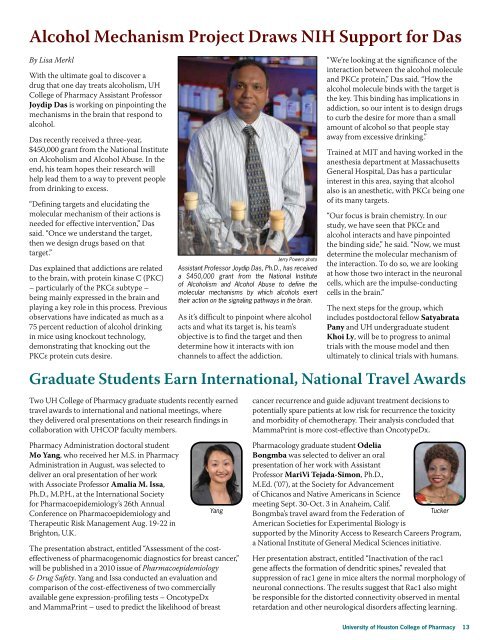University of Houston College of Pharmacy - the STEM Digital Village
University of Houston College of Pharmacy - the STEM Digital Village
University of Houston College of Pharmacy - the STEM Digital Village
You also want an ePaper? Increase the reach of your titles
YUMPU automatically turns print PDFs into web optimized ePapers that Google loves.
Alcohol Mechanism Project Draws NIH Support for Das<br />
By Lisa Merkl<br />
With <strong>the</strong> ultimate goal to discover a<br />
drug that one day treats alcoholism, UH<br />
<strong>College</strong> <strong>of</strong> <strong>Pharmacy</strong> Assistant Pr<strong>of</strong>essor<br />
Joydip Das is working on pinpointing <strong>the</strong><br />
mechanisms in <strong>the</strong> brain that respond to<br />
alcohol.<br />
Das recently received a three-year,<br />
$450,000 grant from <strong>the</strong> National Institute<br />
on Alcoholism and Alcohol Abuse. In <strong>the</strong><br />
end, his team hopes <strong>the</strong>ir research will<br />
help lead <strong>the</strong>m to a way to prevent people<br />
from drinking to excess.<br />
“Defining targets and elucidating <strong>the</strong><br />
molecular mechanism <strong>of</strong> <strong>the</strong>ir actions is<br />
needed for effective intervention,” Das<br />
said. “Once we understand <strong>the</strong> target,<br />
<strong>the</strong>n we design drugs based on that<br />
target.”<br />
Das explained that addictions are related<br />
to <strong>the</strong> brain, with protein kinase C (PKC)<br />
– particularly <strong>of</strong> <strong>the</strong> PKCε subtype –<br />
being mainly expressed in <strong>the</strong> brain and<br />
playing a key role in this process. Previous<br />
observations have indicated as much as a<br />
75 percent reduction <strong>of</strong> alcohol drinking<br />
in mice using knockout technology,<br />
demonstrating that knocking out <strong>the</strong><br />
PKCε protein cuts desire.<br />
Jerry Powers photo<br />
Assistant Pr<strong>of</strong>essor Joydip Das, Ph.D., has received<br />
a $450,000 grant from <strong>the</strong> National Institute<br />
<strong>of</strong> Alcoholism and Alcohol Abuse to define <strong>the</strong><br />
molecular mechanisms by which alcohols exert<br />
<strong>the</strong>ir action on <strong>the</strong> signaling pathways in <strong>the</strong> brain.<br />
As it’s difficult to pinpoint where alcohol<br />
acts and what its target is, his team’s<br />
objective is to find <strong>the</strong> target and <strong>the</strong>n<br />
determine how it interacts with ion<br />
channels to affect <strong>the</strong> addiction.<br />
“We’re looking at <strong>the</strong> significance <strong>of</strong> <strong>the</strong><br />
interaction between <strong>the</strong> alcohol molecule<br />
and PKCε protein,” Das said. “How <strong>the</strong><br />
alcohol molecule binds with <strong>the</strong> target is<br />
<strong>the</strong> key. This binding has implications in<br />
addiction, so our intent is to design drugs<br />
to curb <strong>the</strong> desire for more than a small<br />
amount <strong>of</strong> alcohol so that people stay<br />
away from excessive drinking.”<br />
Trained at MIT and having worked in <strong>the</strong><br />
anes<strong>the</strong>sia department at Massachusetts<br />
General Hospital, Das has a particular<br />
interest in this area, saying that alcohol<br />
also is an anes<strong>the</strong>tic, with PKCε being one<br />
<strong>of</strong> its many targets.<br />
“Our focus is brain chemistry. In our<br />
study, we have seen that PKCε and<br />
alcohol interacts and have pinpointed<br />
<strong>the</strong> binding side,” he said. “Now, we must<br />
determine <strong>the</strong> molecular mechanism <strong>of</strong><br />
<strong>the</strong> interaction. To do so, we are looking<br />
at how those two interact in <strong>the</strong> neuronal<br />
cells, which are <strong>the</strong> impulse-conducting<br />
cells in <strong>the</strong> brain.”<br />
The next steps for <strong>the</strong> group, which<br />
includes postdoctoral fellow Satyabrata<br />
Pany and UH undergraduate student<br />
Khoi Ly, will be to progress to animal<br />
trials with <strong>the</strong> mouse model and <strong>the</strong>n<br />
ultimately to clinical trials with humans.<br />
Graduate Students Earn International, National Travel Awards<br />
Two UH <strong>College</strong> <strong>of</strong> <strong>Pharmacy</strong> graduate students recently earned<br />
travel awards to international and national meetings, where<br />
<strong>the</strong>y delivered oral presentations on <strong>the</strong>ir research findings in<br />
collaboration with UHCOP faculty members.<br />
<strong>Pharmacy</strong> Administration doctoral student<br />
Mo Yang, who received her M.S. in <strong>Pharmacy</strong><br />
Administration in August, was selected to<br />
deliver an oral presentation <strong>of</strong> her work<br />
with Associate Pr<strong>of</strong>essor Amalia M. Issa,<br />
Ph.D., M.P.H., at <strong>the</strong> International Society<br />
for Pharmacoepidemiology’s 26th Annual<br />
Conference on Pharmacoepidemiology and<br />
Therapeutic Risk Management Aug. 19-22 in<br />
Brighton, U.K.<br />
Yang<br />
The presentation abstract, entitled “Assessment <strong>of</strong> <strong>the</strong> costeffectiveness<br />
<strong>of</strong> pharmacogenomic diagnostics for breast cancer,”<br />
will be published in a 2010 issue <strong>of</strong> Pharmacoepidemiology<br />
& Drug Safety. Yang and Issa conducted an evaluation and<br />
comparison <strong>of</strong> <strong>the</strong> cost-effectiveness <strong>of</strong> two commercially<br />
available gene expression-pr<strong>of</strong>iling tests – OncotypeDx<br />
and MammaPrint – used to predict <strong>the</strong> likelihood <strong>of</strong> breast<br />
cancer recurrence and guide adjuvant treatment decisions to<br />
potentially spare patients at low risk for recurrence <strong>the</strong> toxicity<br />
and morbidity <strong>of</strong> chemo<strong>the</strong>rapy. Their analysis concluded that<br />
MammaPrint is more cost-effective than OncotypeDx.<br />
Pharmacology graduate student Odelia<br />
Bongmba was selected to deliver an oral<br />
presentation <strong>of</strong> her work with Assistant<br />
Pr<strong>of</strong>essor MariVi Tejada-Simon, Ph.D.,<br />
M.Ed. (’07), at <strong>the</strong> Society for Advancement<br />
<strong>of</strong> Chicanos and Native Americans in Science<br />
meeting Sept. 30-Oct. 3 in Anaheim, Calif.<br />
Bongmba’s travel award from <strong>the</strong> Federation <strong>of</strong> Tucker<br />
American Societies for Experimental Biology is<br />
supported by <strong>the</strong> Minority Access to Research Careers Program,<br />
a National Institute <strong>of</strong> General Medical Sciences initiative.<br />
Her presentation abstract, entitled “Inactivation <strong>of</strong> <strong>the</strong> rac1<br />
gene affects <strong>the</strong> formation <strong>of</strong> dendritic spines,” revealed that<br />
suppression <strong>of</strong> rac1 gene in mice alters <strong>the</strong> normal morphology <strong>of</strong><br />
neuronal connections. The results suggest that Rac1 also might<br />
be responsible for <strong>the</strong> distorted connectivity observed in mental<br />
retardation and o<strong>the</strong>r neurological disorders affecting learning.<br />
<strong>University</strong> <strong>of</strong> <strong>Houston</strong> <strong>College</strong> <strong>of</strong> <strong>Pharmacy</strong> 13


